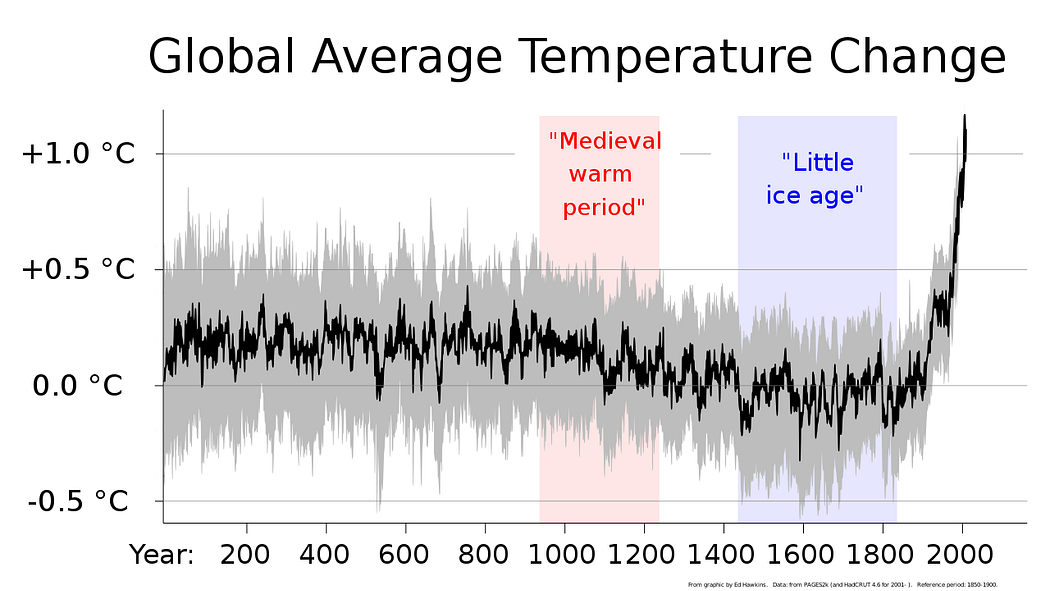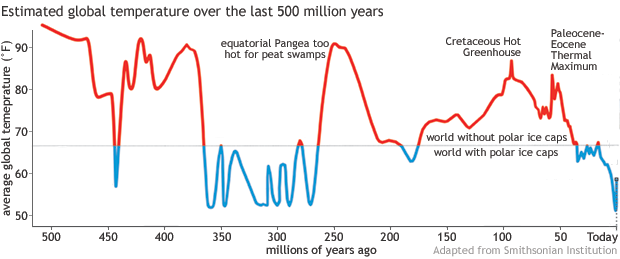Climate change deniers argue that the world is cooling
How they use faulty statistics to uphold lies about the ongoing crisis
Tim Andersen, Ph.D.

Photo by Ryan Loughlin on UnsplashI recently saw a post on twitter called “The staircase of denial”.
The basic premise is that you constantly see claims that the world has been cooling over the last 8 years or for a period of 10 years when it was supposed to be warming.
Typically, these strings of cooling are chosen very carefully to start with a hot year and end on a cooler year. If you draw a sequence of such trends over several decades, you see what looks like a staircase. The overall trend is very clear: up, up, and up some more.
This is just one way to lie with statistics which brings to mind the three types of lies, according to Mark Twain, lies, damned lies, and statistics.
Skeptical science put together a similar graphic which you can find here.
This particular crime against truth is called cherry-picking because climate deniers are picking the years to look at instead of the overall trend.
Each year different factors like El Niño and La Niña determine the global average temperature. You find patterns of stability or even cooling within the overall upward trend.
If you look further back to the 19th century, however, you find that the trend was stable. The temperature was not rising decade in and out.

RCraig09 Creative Commons Attribution-Share Alike 4.0 InternationalWe know that human beings are causing this warming because we have very good models for average temperature based on the levels of CO2 in the atmosphere. We can measure that and see it is rising every year. We also know how much of that comes from burning fossil fuels.
It’s pretty simple to extrapolate from that what our portion of guilt is. It turns out to be all of the rise. In other words, the natural causes cannot explain any of the increase.
So, that brings another question: is it really so bad?
I saw a video of Jordan Peterson asking this question. Perhaps all the extra CO2 will make the planet greener by feeding green plants more. Perhaps it will make less fertile areas more fertile.
This is as if I commented on a trend in psychology: what if increasing isolation among teens is a good thing? Maybe they will contemplate their lives more, develop interesting hobbies, and stay away from bad influences. Would anyone take me seriously? I wouldn’t.
Peterson has baited climate scientists before suggesting on Joe Rogan’s show, where he has no chance of being contradicted, that climate models aren’t able to model climate change accurately because they don’t contain “everything”.
This is, in the words of Wolfgang Pauli, not even wrong.
Now, truthfully, we do have to address why global warming is bad and much of it has to do with how fast it is happening rather than the fact that it is happening. A slow warming trend over 10,000–100,000 years we would just adapt to, but the Earth right now is warming faster than it has ever warmed in the past.
Over the Earth’s history, average temperature has been far from fixed. It has experienced wild swings far below and above the current mean but these happened over long periods.
Over the Phanerozoic Eon, the last half billion years, the global temperature has often been very, very hot. In fact, 500 million years ago, prior to land based plants absorbing atmospheric CO2, the Earth was blistering at a global average over 90 degrees (32 C). The current average is about 57 (13.9 C).

Once land plants evolved, the temperature dropped but it didn’t stay low. Because of volcanic activity, the motion of the continents, and oscillations in Earth’s tilt, it has dropped and climbed many times.
In the last 100 million years, it has been very hot twice: once about 92 million years ago and again about 55 million years ago.
During those periods, there were no polar ice caps and palm trees grew north of the Arctic Circle while crocodiles plied arctic rivers.
Those warm periods were caused by releases of carbon dioxide but we don’t know exactly where it came from. Perhaps from the oceans.
All these climates occurred before human beings existed and human civilization developed just after one of the colder periods in our planet’s history.
It wasn’t the coldest. The coldest period was actually about 650 million years ago when many scientists hypothesize that the entire Earth’s surface was frozen over in the Snowball Earth period. At this time, the Earth would have had temperatures in the -50 C region, as cold as modern Antarctica, at the equator.
Nevertheless, for the period of time when multicellular life has filled the Earth, we are in one of the colder periods.
It is clear that human beings at least individually could probably survive in a much hotter Earth since it has been much hotter in the past and human beings have adapted to living in hot places. We aren’t talking about Venusian temperatures that can melt lead. The problem isn’t that. It’s whether human civilization can survive a rapid warming scenario.
Ironically, the Earth may have some self correcting mechanisms that bring the climate back in line when it drifts too far one way or another. One of these might be destroying human civilization so it can no longer produce greenhouse gases from fossil fuel burning.
Jokes aside, the current warming trend is not good for fertility. Instead it will likely lead to increased desertification, loss of fresh water from snowpack, and the inundation of coastal cities and farms by the sea as the ice caps melt.
In addition we will see the acceleration of the current mass extinction taking place, with thousands of species dying out because of the warming of their habitats as well as the encroachment of human settlement.
One of the worst effects comes from heat itself. As we saw in the “heat dome” incident in the Pacific Northwest of the United States, unusual heat phenomena can occur that are deadly to anyone without access to cooling. The poor and homeless are impacted especially.
In fact, there is a measure called the Wet Bulb temperature that is, essentially, what the temperature would be if water were added to the air until it reached 100% humidity. When this temperature gets above 95 degrees (35 C), human beings can’t live for more than a couple hours.
Right now, there is no place on Earth where the wet bulb temperature reaches that hot for any sustained period of time, but, if there were and it were in a populated area, it could cause millions of deaths. Even wet bulb temperatures above 80 can cause significant deaths in places that aren’t prepared for it such as Europe.
And if people die from this, so do plants and animals. Indeed, livestock will die in the millions as well if a powerful heat wave hits and this has already happened, meaning the food supply will be impacted.
All of this may seem survivable if you are a typical middle class inhabitant of an industrialized nation, but, for the most vulnerable populations on Earth, it will be devastating. It will not make their crops grow better. The lack of water and extreme heat will cause them to fail. It will not make marginal land in the far north more inhabitable but rather it will bring disastrous heat waves to people, plants, and animals that are unprepared for them.
This is why the staircase of denial eventually becomes a staircase to hell.
There is no way we can go back to a pre-industrial way of life with the number of people on this planet and the climate is already changing. Stopping climate change from getting any worse requires we change our sources of energy.
Probably the biggest need right now is for industrialized nations to deactivate their fossil fuel burning power plants. While electric cars and home solar sound nice, they aren’t an easily scaled sustainable solution. Unfortunately, some nations such as Germany have chosen to scale up fossil fuel burning because of long debunked fears of nuclear power.
Given the slow growth and lack of reliability of renewables, nuclear is an important baseline and so we should be building more plants, not replacing them. We should also be investing in proven technologies to burn spent nuclear fuel, which will reduce the need to store it. Scaling up renewables is important too, but we don’t have time to eschew fission or indulge in fantasies about nuclear fusion.
This will not only help reduce carbon emissions but drive battery powered devices, especially cars, to reduce their carbon emissions as well and allow factories to produce goods without emissions as well. This will have a snowballing effect on the carbon footprint of the entire economy.
Ultimately, the doomsday scenarios that some alarmists predict will likely not come to pass. Rather, we will see a world that is vastly different than the one our ancestors experienced, one that is far less habitable to human life as we have known it. Because of the rapid increase of carbon emissions, and the fact that, even after emissions are reduced we expect to see additional warming, we will have to adapt even more rapidly, with a level of mobilization unseen since perhaps World War 2. As ecological regions continue to collapse, it will become increasingly important to protect what is left, but it isn’t clear yet whether that will be possible without a major shift in economic priorities.
It is no wonder that post-apocalyptic science fiction is so popular right now. The Zombie apocalypse is just a stand in for the devastation that we know is happening.
Most people are just trying to get by while the rich hoard what is needed to truly save the world and waste it on self-serving wealth-building. That will have to stop as well.
It’s pointless at this point to say that time is running out. Time has run out. We are in damage control now. |






